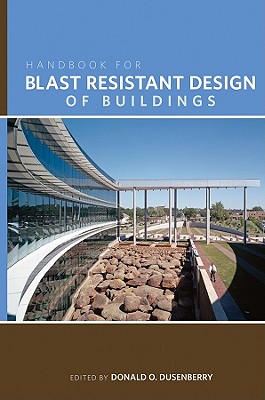Handbook for Blast Resistant Design of Buildings
Handbook for Blast-Resistant Design of Buildings
HANDBOOK FOR
BLAST-RESISTANT
DESIGN OF BUILDINGS
Edited by Donald 0. Dusenberry
Copyright 0 2010 by John Wiley & Sons, Inc. All rights reserved.
Edited by
Donald O. Dusenberry

PREFACE
The need for protection against the effects of explosions is not new. The use
of explosive weaponry by the military necessitated resistive entrenchments ages
ago. Industrialization of our societies well over a century ago meant that we
intended to manufacture, store, handle, and use explosives in constructive ways.
To support these military and industrial purposes, a relatively small group of
designers have worked to devise ways to strengthen the blast resistance of our
structures.
Early attempts at blast-resistance design necessarily relied on judgment, test,
and trial-and-error construction to find the best solutions. As technology improved,
designers became better able to predict the influences of explosions
and the resistive responses that they strove to impart into their designs. More
recently, in the past several decades chemists, physicists, blast consultants, and
structural engineers have been empowered by technologies and computational
tools that have enhanced the precision of their analyses and the efficiency of their
designs.
At the same time, the need has increased. The small contingent of designers
skilled in the art and science of creating structural designs that will resist explosive
forces has been joined by a larger group of architects, engineers, blast
consultants, and security consultants who are trying to respond to the increasing
concern from a broader group of clients who fear an exposure that they did
not anticipate before and frequently did not bring upon themselves. Consultants
who have never before had to assess risks, devise risk-reduction programs, provide
security systems, establish design-base threats, calculate the pressures and
impulses from explosions, and create cost-effective structural designs are being
thrust into the process. Many are ill-trained to respond.
There are several good references on some of the aspects of designing for
blast resistance. Some of these references support military purposes or for other
reasons have government-imposed restrictions against dissemination. As such,
they are not widely available to consultants working in the private sector. Nearly
all those references and the references that are public each treat an aspect of
blast phenomenology, security systems, and structural design for blast resistance,
but few, if any, bring together in one place discussions of the breadth of the
issues that are important for competent designs. Consultants are forced to collect
a library of references and extract from each the salient information that they
then synthesize into a comprehensive design approach.
Download
http://s18.alxa.net/s18/srvs2/01/Han....Buildings.rar